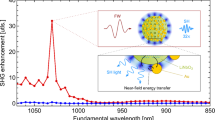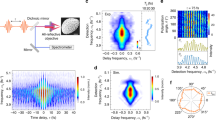Abstract
The ability to convert low-energy quanta into a quantum of higher energy is of great interest for a variety of applications, including bioimaging1, drug delivery2 and photovoltaics3. Although high conversion efficiencies can be achieved using macroscopic nonlinear crystals, upconverting light at the nanometre scale remains challenging because the subwavelength scale of materials prevents the exploitation of phase-matching processes4. Light–plasmon interactions that occur in nanostructured noble metals have offered alternative opportunities for nonlinear upconversion of infrared light, but conversion efficiency rates remain extremely low due to the weak penetration of the exciting fields into the metal5. Here, we show that third-harmonic generation from an individual semiconductor indium tin oxide nanoparticle is significantly enhanced when coupled within a plasmonic gold dimer. The plasmonic dimer acts as a receiving optical antenna6, confining the incident far-field radiation into a near field localized at its gap; the indium tin oxide nanoparticle located at the plasmonic dimer gap acts as a localized nonlinear transmitter upconverting three incident photons at frequency ω into a photon at frequency 3ω. This hybrid nanodevice provides third-harmonic-generation enhancements of up to 106-fold compared with an isolated indium tin oxide nanoparticle, with an effective third-order susceptibility up to 3.5 × 103 nm2 V−2 and conversion efficiency of 0.0007%. We also show that the upconverted third-harmonic emission can be exploited to probe the near-field intensity at the plasmonic dimer gap.
This is a preview of subscription content, access via your institution
Access options
Subscribe to this journal
Receive 12 print issues and online access
$259.00 per year
only $21.58 per issue
Buy this article
- Purchase on Springer Link
- Instant access to full article PDF
Prices may be subject to local taxes which are calculated during checkout



Similar content being viewed by others
References
Débarre, D. et al. Imaging lipid bodies in cells and tissues using third-harmonic generation microscopy. Nature Methods 3, 47–53 (2006).
Zhou, J., Liu, Z. & Li, F. Upconversion nanophosphors for small-animal imaging. Chem. Soc. Rev. 41, 1323–1349 (2012).
Zou, W. Q., Visser, C., Maduro, J. A., Pshenichnikov, M. S. & Hummelen, J. C. Broadband dye-sensitized upconversion of near-infrared light. Nature Photon. 6, 560–564 (2012).
Agio, M. & Alù, A. Optical Antennas (Cambridge Univ. Press, 2013).
Kauranen, M. & Zayats, A. V. Nonlinear plasmonics. Nature Photon. 6, 737–748 (2012).
Novotny, L. & van Hulst, N. Antennas for light. Nature Photon. 5, 83–90 (2011).
Franken, P. A., Hill, A. E., Peter, C. W. & Weinreich, G. Generation of optical harmonics. Phys. Rev. Lett. 7, 118–119 (1961).
Xie, X. S., Yu, J. & Yang, W. Y. Living cells as test tubes. Science 312, 228–230 (2006).
Tian, G. et al. Mn2+ dopant-controlled synthesis of NaYF4:Yb/Er upconversion nanoparticles for in vivo imaging and drug delivery. Adv. Mater. 24, 1226–1231 (2012).
Wang, H-Q., Batentschuk, M., Osvet, A., Pinna, L. & Brabec, C. J. Rare-earth ion doped up-conversion materials for photovoltaic applications. Adv. Mater. 23, 2675–2680 (2011).
Lamprecht, B., Krenn, J. R., Leitner, A. & Aussenegg, F. R. Resonant and off-resonant light-driven plasmons in metal nanoparticles studied by femtosecond-resolution third-harmonic generation. Phys. Rev. Lett. 83, 4421 (1999).
Mühlschlegel, P., Eisler, H-J., Martin, O. J. F., Hecht, B. & Pohl, D. W. Resonant optical antennas. Science 308, 1607–1609 (2005).
Schuck, P. J., Fromm, D. P., Sundaramurthy, A., Kino, G. S. & Moerner, W. E. Improving the mismatch between light and nanoscale objects with gold bowtie nanoantennas. Phys. Rev. Lett. 94, 017402 (2005).
Cai, W., Vasudev, A. P. & Brongersma, M. L. Electrically controlled nonlinear generation of light with plasmonics. Science 333, 1720–1723 (2011).
Abb, M., Albella, P., Aizpurua, J. & Muskens, O. L. All-optical control of a single plasmonic nanoantenna–ITO hybrid. Nano Lett. 11, 2457–2463 (2011).
Kim, S. et al. High-harmonic generation by resonant plasmon field enhancement. Nature 453, 757–760 (2008).
Hanke, T. et al. Tailoring spatiotemporal light confinement in single plasmonic nanoantennas. Nano Lett. 12, 992–996 (2012).
Hentschel, M., Utikal, T., Giessen, H. & Lippitz, M. Quantitative modeling of the third harmonic emission spectrum of plasmonic nanoantennas. Nano Lett. 12, 3778–3782 (2012).
Melentiev, P. N., Afanasiev, A. E., Kuzin, A. A., Baturin, S. A. & Balykin, V. I. Giant optical nonlinearity of a single plasmonic nanostructure. Opt. Express. 21, 13896–13905 (2013).
Koller, D. M. et al. Superresolution Moiré mapping of particle plasmon modes. Phys. Rev. Lett. 104, 143901 (2010).
Dregely, D., Neubrech, F., Duan, H., Vogelgesang, R. & Giessen, H. Vibrational near-field mapping of planar and buried three-dimensional plasmonic nanostructures. Nature Commun. 4, 2237 (2013).
Bermúdez Ureña, E. et al. Excitation enhancement of a quantum dot coupled to a plasmonic antenna. Adv. Mater. 24, OP314–OP320 (2012).
Liu, N. et al. Individual nanoantennas loaded with three-dimensional optical nanocircuit. Nano Lett. 13, 142–147 (2013).
Palik, E. D. Handbook of Optical Constants of Solids (Academic, 1985).
Humphrey, J. L. & Kuciauskas, D. Optical susceptibilities of supported indium tin oxide thin films. J. Appl. Phys. 100, 113123 (2006).
Alaverdyan, Y. et al. Spectral tunability of a plasmonic antenna with a dielectric nanocrystal. Opt. Express 19, 18175–18181 (2011).
Giannini, V., Fernández-Domínguez, A. I., Heck, S. C. & Maier, S. A. Plasmonic nanoantennas: fundamentals and their use in controlling the radiative properties of nanoemitters. Chem. Rev. 6, 3888–3912 (2011).
Ganeev, R. A., Kulagin, I. A., Ryasnyansky, A. I., Tugushev, R. I. & Usmanov, T. Characterization of nonlinear optical parameters of KDP, LiNbO3 and BBO crystals. Opt. Commun. 229, 403–412 (2004).
Harutyunyan, H., Volpe, G., Quidant, R. & Novotny, L. Enhancing the nonlinear optical response using multifrequency gold-nanowire antennas. Phys. Rev. Lett. 108, 217403 (2012).
Navarro-Cia, M. & Maier, S. A. Broad-band near-infrared plasmonic nanoantennas for higher harmonic generation. ACS Nano 6, 3537–3544 (2012).
Acknowledgements
The authors thank A. Rakovich for fabrication of preliminary samples, Y. Sonnefraud for help with sample characterization and V. Giannini and A. I. Fernández-Domínguez for discussions. This work was funded by the Engineering and Physical Sciences Research Council (EPSRC) through the Active Plasmonics programme, the Leverhulme Trust, the US Army International Technology Centre Atlantic (USAITC-A) and the Office of Naval Research (ONR and ONR Global). M.N-C. is supported by an Imperial College Junior Research Fellowship.
Author information
Authors and Affiliations
Contributions
H.A. and S.A.M. conceived and supervised the project. M.N-C. provided the numerical work, M.R. fabricated the samples and H.A. performed the experiments. H.A. wrote the manuscript. All authors participated in data processing, analysis, discussions and manuscript preparation.
Corresponding author
Ethics declarations
Competing interests
The authors declare no competing financial interests.
Supplementary information
Supplementary information
Supplementary information (PDF 1924 kb)
Rights and permissions
About this article
Cite this article
Aouani, H., Rahmani, M., Navarro-Cía, M. et al. Third-harmonic-upconversion enhancement from a single semiconductor nanoparticle coupled to a plasmonic antenna. Nature Nanotech 9, 290–294 (2014). https://doi.org/10.1038/nnano.2014.27
Received:
Accepted:
Published:
Issue Date:
DOI: https://doi.org/10.1038/nnano.2014.27
This article is cited by
-
An on-Si directional second harmonic generation amplifier for MoS2/WS2 heterostructure
Nano Research (2023)
-
Low Loss Hybrid Plasmonic Waveguide with Variable Nonlinearity and Ultralow Dispersion
Plasmonics (2022)
-
The geometric phase in nonlinear frequency conversion
Frontiers of Physics (2022)
-
Nonlinear meta-optics towards applications
PhotoniX (2021)
-
Full-color enhanced second harmonic generation using rainbow trapping in ultrathin hyperbolic metamaterials
Nature Communications (2021)



